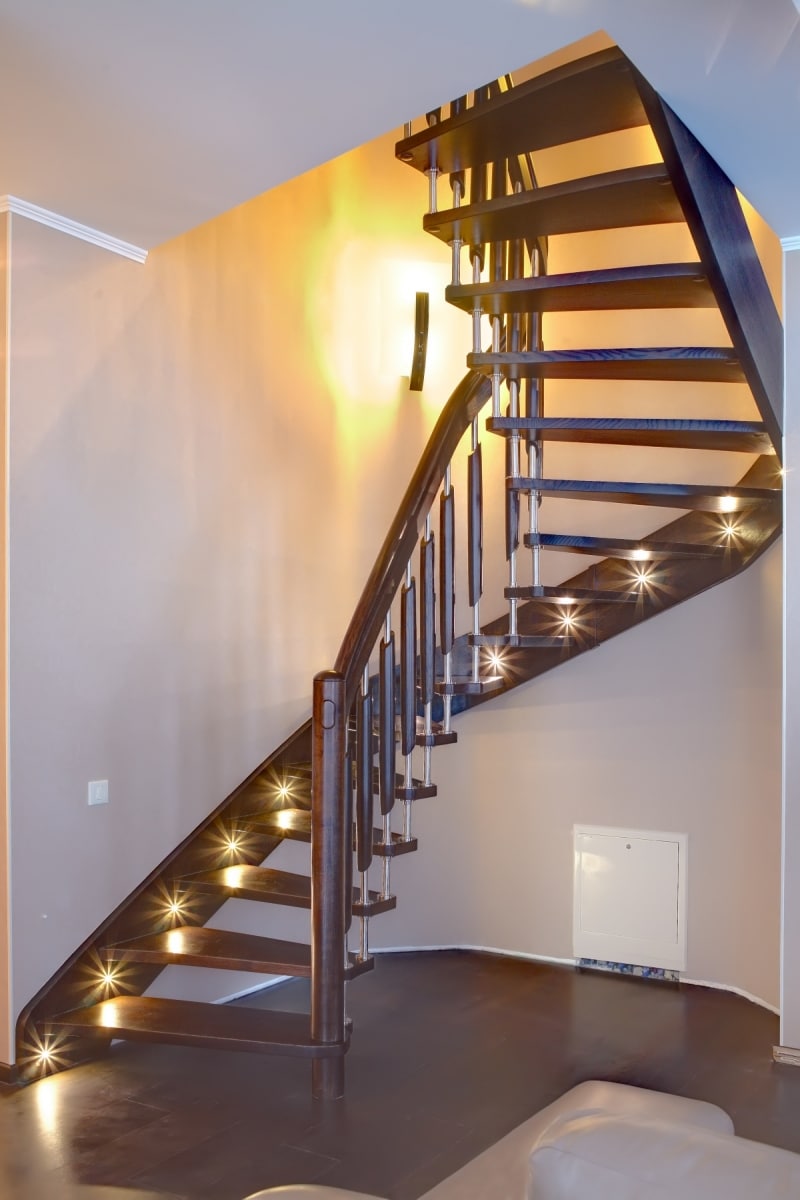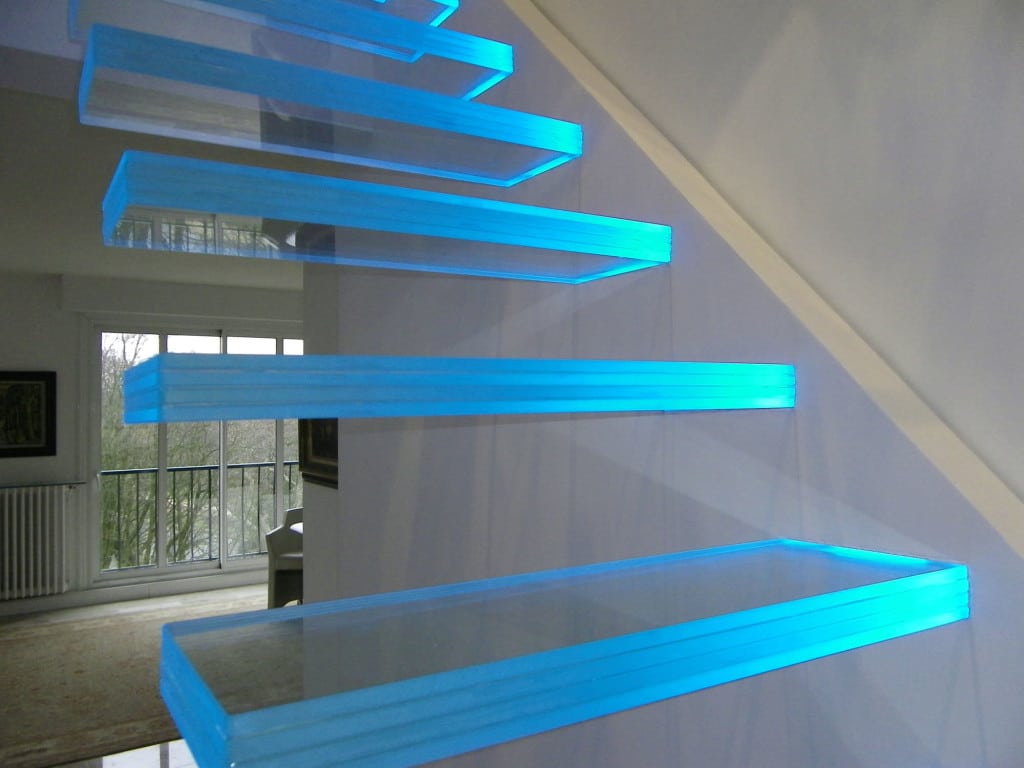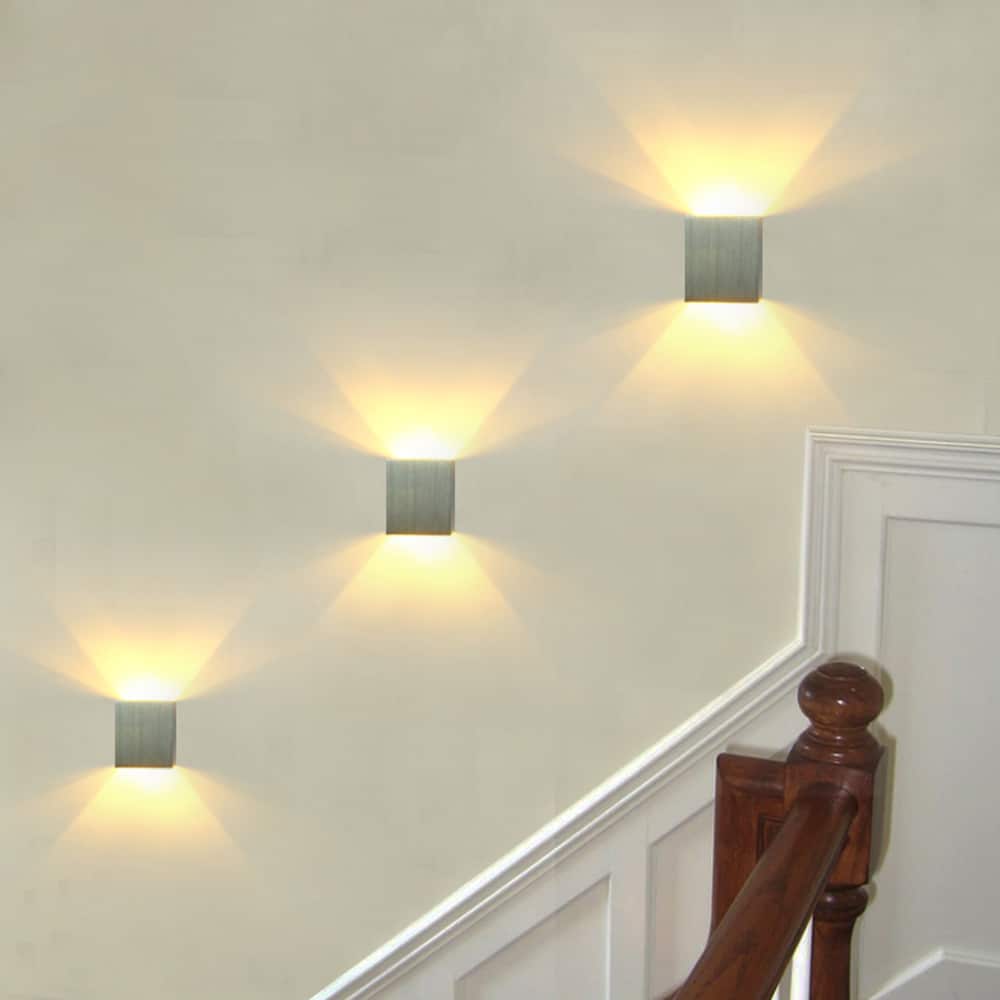
The correct location of the fixtures does not distort the contours of the steps and allows you to avoid shaded areas, as a result, a person can safely climb to the second floor or go down from it. The span is illuminated with LED, neon and halogen lamps. The use of specific equipment depends on the material and configuration of the flight of stairs.
Wooden stairs should not be equipped with halogen lamps, as this type of lamp gets very hot during operation, which can lead to fire.
Lighting devices are usually placed along the length of the steps, on the side surfaces, or they are mounted above them in the form of chandeliers or sconces. The color of the lighting also plays a significant role, as wooden surfaces are best emphasized by a warm, yellowish light, and a cold, white shade is preferable for metal products.
The installation of special lighting for flights of stairs is mandatory if the house is permanently inhabited by:
The lighting of the stairs in a private house is carried out in such a way that the structural elements of the product are perfectly visible, but the person is not blinded by directional light. The type of illumination depends on the type of flight of stairs.
A feature of screw structures is the use of rounded steps. This configuration is best played with LED strip. Traditionally, spiral staircases are small, so fences and a side wall are used to place the lighting.
For spiral staircases, illumination of each step is mandatory.

The implementation of LED lighting of the stairs is possible if the steps do not have risers, since the tube with LEDs is installed from the inside, directing the flow of light to the step below. If the risers are equipped, then spotlights or overhead lighting are placed.
Transparent steps are made of reinforced glass or acrylic. To illuminate marches of this type, a diffusing screen is installed at the ends of the steps, which allows you to create the effect of full illumination of the steps. If the handrails are made of acrylic, you should direct the light stream to the end, which allows you to achieve the effect of an inner glow.

Illumination of the stairs with LED strip in this case is not possible. The best option for lighting concrete stairs is side lighting on the wall at a level of 40-50 cm from the surface of the steps, you can also use the option with chandelier lighting (with a sufficient span height).
Automatic staircase lighting is not only a convenient option for illuminating the space, but also a great way to save energy. Special sensors react to the movement of a person or are triggered by a sound signal, while the light turns off automatically after the person has left the room.
Smart staircase lighting is configured to meet the needs of residents of a country house, for which sensors are used.
The motion sensor is triggered when the tenant moves and turns on the backlight of the stairs at the moment of crossing a certain space. When a person leaves the room, the light turns off automatically for a pre-programmed time. The use of this sensor is recommended for one luminaire operation mode.
Illumination of stairs on steps with a motion sensor equipped with sensor protection against atmospheric precipitation allows illumination of external spans. A sensor with a timer or on a photocell will turn on the light at certain hours. This option allows you to turn on the lighting of external stairs at night or at a programmed time.
The load sensor reacts to external influences and closes the circuit when pressure is applied to the steps or when the railing is touched. The sound sensor is adjusted to the voice of a person or cotton, turning the light on and off on a sound command.
The use of autonomous energy sources makes it possible to organize safe and reliable illumination of flights of stairs. Often, parents arrange wireless lighting of the stairs to the second floor, where the children's bedrooms are located.

For wireless lighting equipment, you will need motion sensors, lamps and batteries, which can be standard high-capacity batteries. Placing this type of lighting in a private house allows you to achieve the following advantages:
Ready-made kits can be installed by any owner of an apartment or a private house with their own hands. A simple assembly scheme and no need to connect to high voltage allow installation without specialists.
Usually, AAA (little finger) batteries are used in ready-made sets of wireless lamps. Motion sensors turn off the light after the cessation of movement for 18 seconds.

Self-installation of electric staircase lighting from the network without special skills is impossible. Working with voltage requires certain knowledge and skills, so it is better to invite a professional to build traditional systems. Improperly installed wiring can cause fire or injury.
To install a traditional system, you will need:
The first step for the lighting equipment of a flight of stairs is to draw up a wiring diagram, after which the circuit elements are purchased and the surfaces are prepared for cable laying. Gating is carried out in concrete surfaces, external cable channels are used for wooden surfaces.
The easiest way to organize lighting using strip LEDs, it is more difficult to install spotlights that are installed flush to the wall surface.

The lamps used in lighting fixtures have their own characteristics and differ in their main characteristics. Traditionally, halogen, neon and LED lamps are used to illuminate flights of stairs.
This type of lamp provides a bright glow, but it generates a lot of heat, so the use of halogen lamps is not recommended in wooden buildings.
In addition to the high degree of heating during operation, halogen lamps are sensitive to changes in mains voltage and in such situations quickly fail.

This type of lamp gives a soft, diffused light, optimally suited for the limited space of a flight of stairs. They are durable, but very sensitive to mechanical stress, and fail at the slightest load.
The most popular type of lamps. The advantages of LED lamps include:
 RGB LEDs.
RGB LEDs. A small lamp, located in the direction of the tenant's movement along the stairs, creates a spectacular illumination of the space, while doing an excellent job with the main function of illuminating the steps.
Based on the location, spotlights are divided into:

This type of lighting is quite popular due to its low power consumption and simple installation scheme. The LED strip is a flexible tube with LEDs inside. There are many color options that will create a harmonious atmosphere in the interior.

When planning the lighting of the stairs, it should be taken into account that in addition to the wiring, it will be necessary to “hide” additional devices (controllers and power supplies). On the surface, the tape is attached to an adhesive base or in a metal profile.
Due to the elasticity of the product, the tape is attached to any surface. Traditionally, it is attached:
The use of chandeliers to illuminate flights of stairs in a private house is justified if there is enough space above the flight. Subject to this condition, you can choose a lighting fixture that suits the style, which will organically fit into the interior.

The use of massive illumination is unlikely to be appropriate in a small cottage, so most often chandeliers are installed in public buildings, where one large chandelier can easily illuminate a two-flight staircase.
The chandelier is suspended from the ceiling, and the electrical connection is made through a cable hidden in the floor panel.
Wall lamps, made in a certain style, serve as a continuation of the overall interior. To connect the wall lamp to a common electrical network, hidden wiring is used, but if the owners do not want to ditch the wall, or lighting is organized in a wooden house, a cable channel with decorative trim is used.

Each lamp can illuminate large areas, and often one sconce is enough for simple stairs, but if a flight of stairs consists of two flights with a turn, then two or three lamps are installed, and the sconces must be placed on the turntable.
All light sources are closed in one circuit, leading to a common switch. If desired, a motion sensor is installed, which will automatically close the circuit when a person moves.
Illumination of stairs with LED strip is a stylish and effective lighting solution for this design. For the LED lighting device, you will need a pair of power supplies. With the use of one, the voltage is converted, the other is necessary for embedding the circuit in the household network.

Making your own backlighting from LEDs is quite simple for any beginner who encounters such equipment for the first time. When purchasing components, the buyer is given an instruction that describes all the conditions and sequence of connection.
If there are protrusions on the steps, the adhesive base of the tube will be sufficient for fastening, and in the absence of this element, an installation profile will have to be used.
To install the staircase lighting using an LED tube, you will need the following tools and materials:





 Illumination scheme for a two-flight staircase.
Illumination scheme for a two-flight staircase.